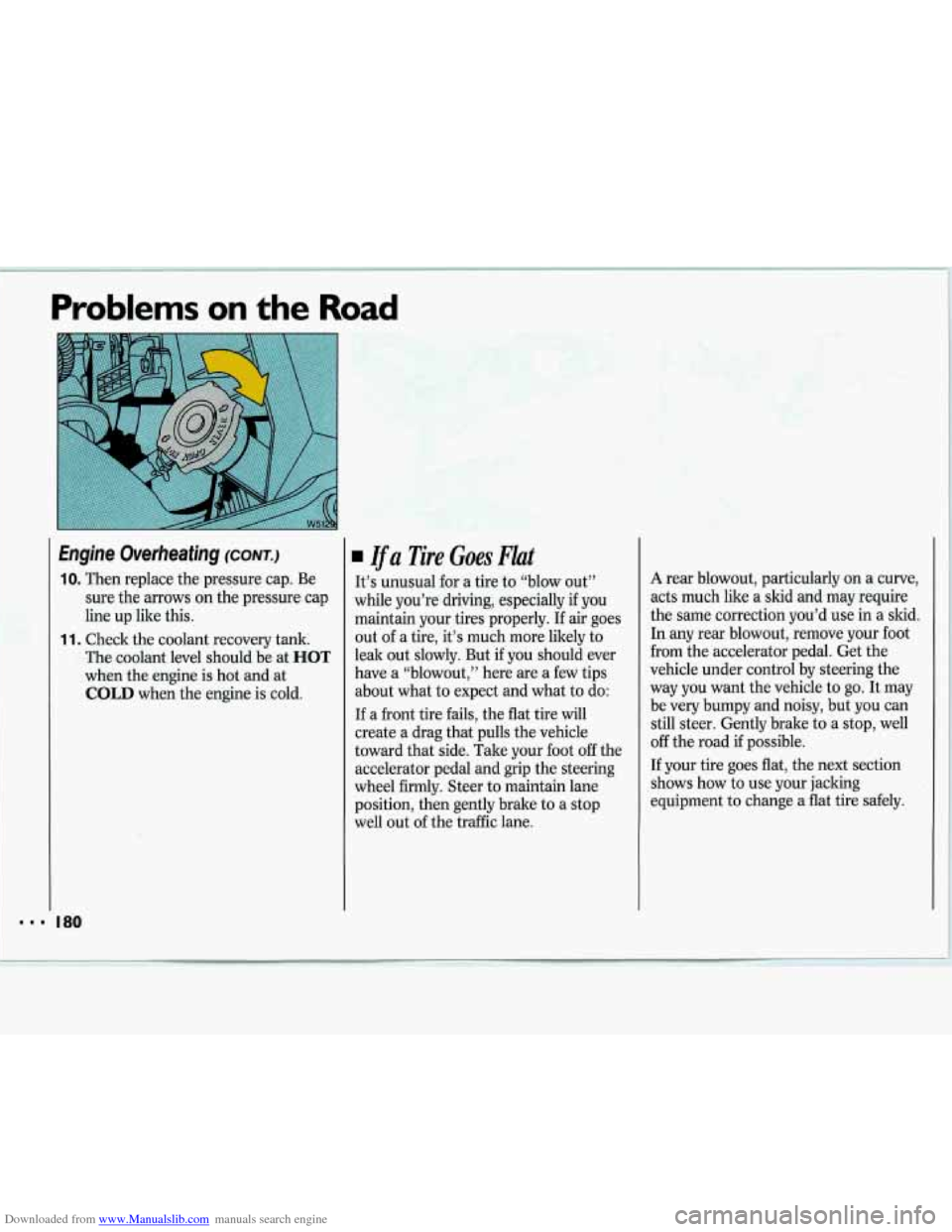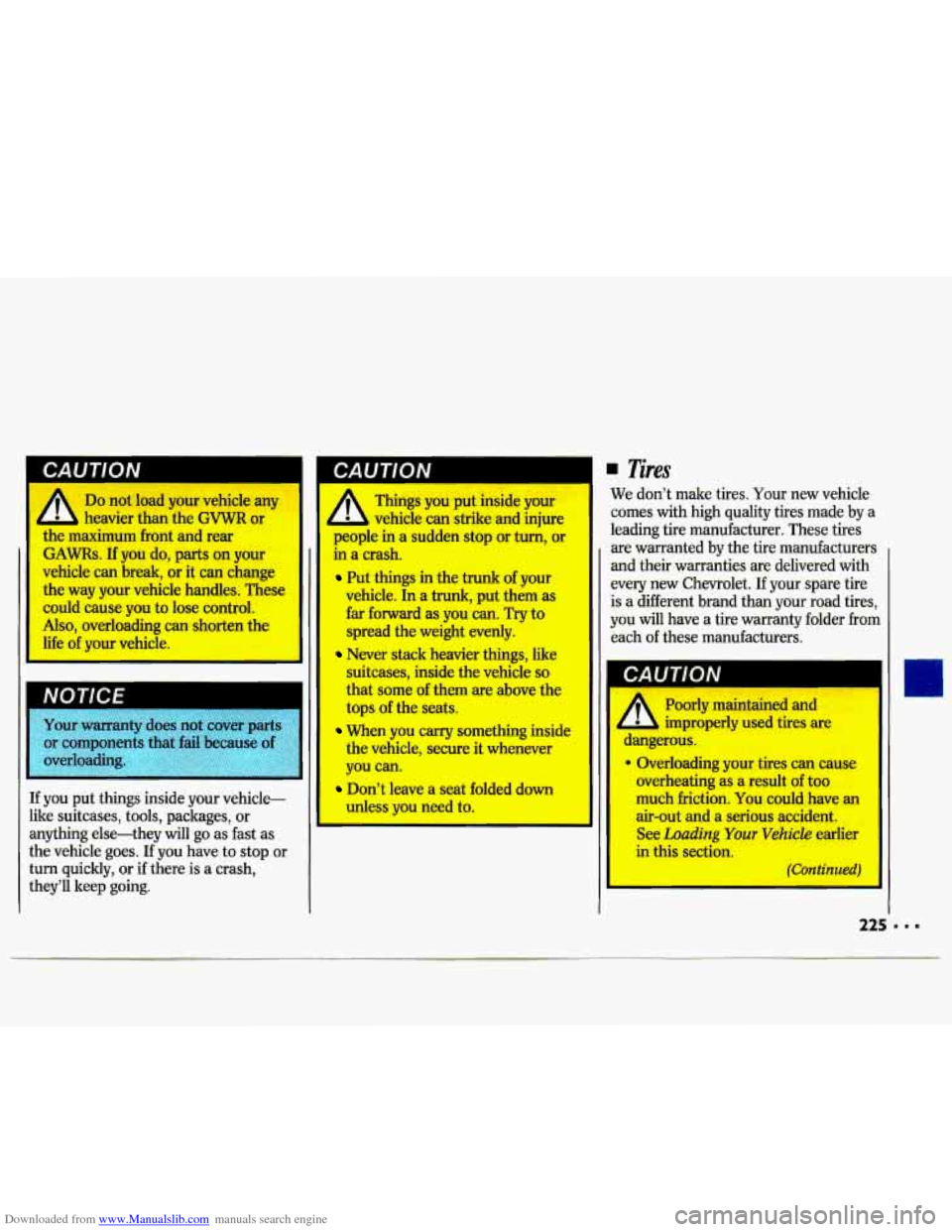1993 CHEVROLET LUMINA tires
[x] Cancel search: tiresPage 182 of 324

Downloaded from www.Manualslib.com manuals search engine Problems on the Road
Engine Overheating (CONT.)
10. Then replace the pressure cap. Be
sure the arrows on the pressure cap
line up like this.
1 1. Check the coolant recovery tank.
The coolant level should be at
HOT
when the engine is hot and at
COLD when the engine is cold.
- i: .:-
Ifa Tire Goes Flat
It’s unusual for a tire to “blow OU~,)
while you’re driving, especially if you
maintain your tires properly. If air goes
out of a tire, it’s much more likely to
leak out slowly. But
if you should ever
have a “blowout,” here are a few tips
about what to expect and what to do:
If a front tire fails, the flat tire will
create a drag that pulls the vehicle
toward that side. Take your foot
off the
accelerator pedal and grip the steering
wheel firmly. Steer to maintain lane
position, then gently brake to a stop
well out of the traffic lane.
A rear blowout, particularly on a curve,
acts much like a
skid and may require
the same correction you’d use in a
skid.
In any rear blowout, remove your foot
from the accelerator pedal. Get the
vehicle under control by steering the
way you want the vehicle to go. It may
be very bumpy and noisy, but you can
still steer. Gently brake to a stop, well
off the road if possible.
If your tire goes flat, the next section
shows how
to use your jacking
equipment to change a
flat tire safely.
Page 189 of 324

Downloaded from www.Manualslib.com manuals search engine Compact Spare Tire
Although the compact spare was fully
inflated when your vehicle was new, it
can lose air after a time. Check the
inflation pressure regularly. It should be
60 psi (420 kPa). The compact spare is
made to go up to
3,000 miles
(5 000 Inn), so you can finish your trip
and have
your full-size tire repaired or
replaced where
you want. Of course, it’s
best to replace your spare with a full-
size tire as soon as you can. Your spare
will last longer and be in good shape in
case you need it again. Your anti-lock
brake system warning light may come
on when you are driving with a compact
spare. See the
Index under Anti-Lock
Brake System Warning Light.
Don’t use your compact spare on some
other vehicle.
And don’t
mix your compact spare or
wheel with other wheels or tires. They
won’t fit. Keep your spare and its wheel
together.
Page 190 of 324

Downloaded from www.Manualslib.com manuals search engine Problems. on the Road
What you don’t want to do when your
vehicle is stuck is to spin your wheels.
The method
known as “rocking” can
help you get out when you’re stuck, but
you must use caution.
CAUTION I
I
r
I
1.1 188
A
If you let your tires spin at
high speed, they can explode
and you or others could be injured.
And, the transaxle or other parts of
the vehicle can overheat. That
could cause an engine compartment
fire or other damage. When you’re stuck, spin the wheels as little as
possible. Don’t spin the wheels
above
35 mph (56 km/h) as shown
on the speedometer. Spinning your wheels can destroy
parts of
your vehicle as well as tht
tires. If you spin the wheels too
fast while shifting your transaxle
back and forth,
YOU~~-&&Q.Y
your transaxle. ~ ~~ ~ 11~1118+~~888 ~:~~,-~~~~~~~~~~,~~~~~~~~~,’,~,’,;,
Rocking Your Vehicle to Get it Out:
First, turn your steering wheel left and
right. That will clear the area around
your front wheels. Then shift back and
forth between
R (Reverse) and a
forward gear (or with a manual
transaxle, between First or Second gear and Reverse), spinning the wheels as
little as possible. Release the accelerator
pedal while you shift, and press lightly
on the accelerator pedal when the
transaxle is in gear. If that doesn’t get
you out after a few tries, you may need
to be towed out.
If you do need to be towed out, see the
Index under Towing Your Chevrolet.
Page 193 of 324

Downloaded from www.Manualslib.com manuals search engine H ere you will find information
about the care of your Chevrolet
.
This part begins with service and
fuel information. and then it shows how to check important fluid and
lubricant levels
. There is also
technical information about your
vehicle. and a section devoted to its
appearance care
.
part 6
Service & Appearance Care
Service ........................................................................\
............................................. 192
Fuel
........................................................................\
.................................................. 193
Hood Release ........................................................................\
................................... 196
Engine Oil ........................................................................\
....................................... 201
Air Cleaner ........................................................................\
...................................... 205
Transaxle Fluid
........................................................................\
................................ 206
Engine Coolant
........................................................................\
................................ 211
Power Steering Fluid
........................................................................\
....................... 214
Windshield Washer Fluid
........................................................................\
................ 215
Brakes
........................................................................\
.............................................. 216
Battery
........................................................................\
............................................. 218
Bulb Replacement
........................................................................\
............................ 218
Windshield Wiper Blade Replacement
.................................................................... 224
Loading Your Vehicle
........................................................................\
...................... 224
Tires
........................................................................\
................................................. 225
Appearance Care
........................................................................\
............................. 232
Vehicle Identification Number (VIN)
.................................................................... 239
Add-on Electrical Equipment
........................................................................\
........ 240
Fuses
& Circuit Breakers ........................................................................\
............... 241
Capacities and Specifications 247
Fluids
& Lubricants ........................................................................\
........................ 249
Replacement Bulbs
........................................................................\
......................... 251
Normal Maintenance Replacement Parts
.............................................................. 254
.. ........................................................................\
..........
Page 226 of 324

Downloaded from www.Manualslib.com manuals search engine Service & Appearance Care
= = 224
Windshield Wiper Blade
Replacement
Replacement blades come in different
types and are removed in different
ways. Here’s how to remove the type
with a release clip:
1. Pull the windshield wiper ann away
2. Lift the release clip with a
from
the windshield.
screwdriver and pull the blade
assembly
off the wiper arm.
the wiper arm.
3. Push the new wiper blade securely on
Loading Your Vehicle
Two labels on your vehicle show how
much weight it may properly carry. The
Tire-Loading Information label found
on the inside of the trunk lid tells you
the proper size, speed rating and
recommended inflation pressures for
the tires on your vehicle. It also gives
you important information about the
number of people that can be in your
vehicle and the total weight that you
can carry. This weight is called the
Vehicle Capacity Weight and includes
the weight of all occupants, cargo, and
all nonfactory-installed options. The
other label is the Certification label,
on the rear edge
of the driver’s door. It
tells you the
gross weight capacity of
your vehicle, called the GVWR (Gross
Vehicle Weight Rating). The
GVWR
includes the weight of the vehicle, all
occupants, fuel and cargo. Never exceed
the GVWR for your vehicle, or the
Gross Axle Weight Rating
(GAWR) for
either the front or rear axle.
And,
if you do have a heavy load, you
should spread it out. Don’t carry more
than
167 lbs. (75 kg) in your trunk.
Page 227 of 324

Downloaded from www.Manualslib.com manuals search engine A
Do not load your vehicle any
Things you put inside your
heavier than the
GVWR or b vehicle can strike and iniure
the maximum front and rear
GAMS. If you do, parts on your
vehicle can break, or it can change
the way your vehicle handles. These
could cause you to lose control.
Also, overloading can shorten the
life of your vehicle.
‘I I
If you put things inside your vehicle-
like suitcases, tools, packages, or
anything else-they
will go as fast as
the vehicle goes. If you have
to stop or
turn quickly, or if there is a crash,
they’ll keep going. people
in a sudden
stop or turn, or
in a crash.
Put things in the trunk of your
vehicle. In a trunk, put them as
far forward
as you can. Try to
spread the weight evenly.
Never stack heavier things, like
suitcases, inside the vehicle
so
that some of them are above the
tops
of the seats.
When you wry something inside
the vehicle, secure it whenever
you can.
Don’t leave a seat folded down
unless
you need to.
. Tires
We don’t make tires. Your new vehicle
comes with high quality tires made by a
leading tire manufacturer. These tires
are warranted
by the tire manufacturers
and their warranties are delivered with
every new Chevrolet. If your spare tire
is a different brand than your road tires,
you will have a tire warranty folder from
each of these manufacturers.
A Poorly maintained and
dangerous.
I improperly used tires are
9 Overloading your tires can cause
overheating as a result of too
much friction. You could have an
air-out and a serious accident.
See Loading Your Vehicle earlier
in this section.
(Continued)
Page 228 of 324

Downloaded from www.Manualslib.com manuals search engine 1,
Service & Appearance Care
Inflation-7ire Pressure
The Tire-Loading Information label
which is on the inside of the trunk lid
shows the correct inflation pressures for
your tires, when they’re cold. “Cold” means your vehicle has been sitting for
at least three hours or driven no more
than a mile. Don’t let anyone tell you
that 1
underinflation or overinflation is
all right. It’s not. If your tires don’t
have enough air (un
Bad fuel econon
If your tires have to
(overinflation) you can get:
Unusual wear [*--
Bad handling
Rough ric,
Needless damage from rp-
hazards.
Page 229 of 324

Downloaded from www.Manualslib.com manuals search engine When to Check:
Check your tires once a month or more.
Don't forget your compact spare tire. It
should be at
60 psi (420 kPa).
How to Check
Use a good quality pocket-type gage to
check tire pressure. Simply looking
at
the tires will not tell you the pressure,
especially
if you have radial tires-
which may look properly inflated even
if
they're underinflated.
If your tires have valve caps, be sure to
put them back on. They help prevent
leaks by keeping out dirt and moisture.
Tire Inspection and Rotation
To make your tires last longer, have
them inspected and rotated at the
mileages recommended in the
Maintenance Schedule. See the
Index
under Scheduled Maintenance
Services.
Use this rotation pattern.
Mer the tires have been rotated, adjust
the front and rear inflation pressure as
shown on the Tire-Loading Information
label. Make certain that
all wheel nuts
are properly tightened. See the
Index
under Wheel Nut Torque.
I
Rust or dirt on a wheel, or on
the parts to which it is
fastened, can make the wheel nuts
become loose after
a time. The
wheel could come
off and cause an
accident. When you change a
wheel, remove any rust
or dirt from
places where the wheel attaches to
the vehicle. In an emergency, you
can use a cloth
or a paper towel to
do this; but be sure to use a scraper
or wire brush later,
if you need to,
to get all the rust or dirt off. (See
the
Index under Changing a Flat
Tire.)
L